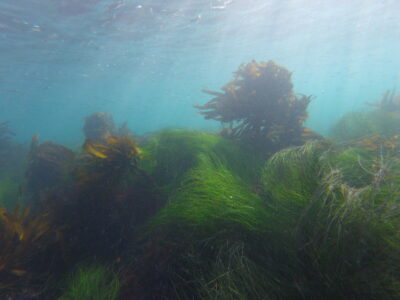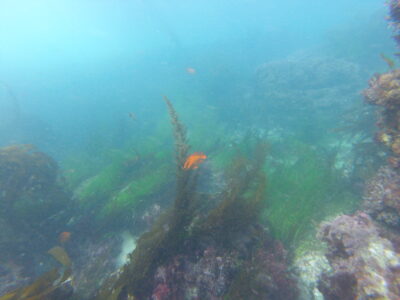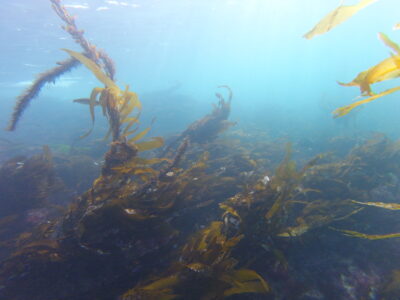
Could California kelp species be the solution to the wild climate change debate? A photosynthetic machine driven by the sun to carry out one duty, remove the excess carbon from the environment. Kelp can be there to save the greater California area from the massive global warming event in place, but humans remain the biggest culprit contributing to the higher temperatures.
Living on a planet where so many aspects fall in line perfectly in order to sustain as much life as Earth does, humans abuse the privilege to the point of their own extinction. Current practices in the greater Southern California have led to the decline of our unique ecosystems due to the excess of carbon gasses polluted throughout the atmosphere creating a warmer environment than before. This human impact has directly affected the Laguna Beach kelp forest’s ability to thrive and fulfill its niche of removing amounts of carbon from the surrounding environment.
In recent years, global carbon dioxide levels have been at a steady 1% increase, coming to 36.2 billion metric ton total in 2021 compared to 4.85 billion in 1940. The local kelp forests have proved vital at regulating their own and surrounding areas by that same carbon sequestration. By doing this it has been able to keep nutrients and organisms fulfilling niches within the ecosystem without coming out of equilibrium, but as the global warming crisis catches up with local oceans the kelp forests are at a loss as they cannot grow in abundance due to the warmer waters directly caused by carbon gasses released by humans. The atmosphere entraps these gasses, referred to as the greenhouse effect (or greenhouse gasses), allowing the environment to be heated up by the sun way too efficiently. The average temperature of the Earth being 57 degrees Fahrenheit is perfect for the Orange County region ecosystems to thrive. Lack of effort from humans can be proven a massive deficit to the ecosystems, though, as these temperatures continue to rise due to that greenhouse effect. Picturesque Southern California Landscapes will soon shift to a dusty, dry desert biome where nutrient-rich soil is rare, and morale is weak.

Nonetheless, scientists are constantly observing and hypothesizing ways in their control to bring the earth back into equilibrium. Dr. Roman de Jesus of Fullerton college describes the kelp in local environments as a “host to an array of biodiversity” as well as “providing the most resources” out of any other organism in the Laguna Beach intertidal and surf zones. Orange county is home to the Giant Kelp species, being able to sequester 30% of all carbon in the surrounding water environment (blue carbon) while giving its own physical shape as a hiding spot for fish species of prey. One mutualistic relationship is between said kelp and California sea otters; the sea otters assist the kelp by preying on the purple sea urchins that graze on the kelp roots, rendering it decreased. The kelp then repays the sea otter for his brave acts of protection by giving a bed of protection for the sea otter to rest and bathe in the sun.
Global carbon dioxide levels have been at a steady 1% increase, coming to a 36.2 billion metric ton total in 2021 compared to 4.85 billion in 1940. These excessive amounts of greenhouse gasses released by human activity every single year have amounted to the warmest years recorded, destroying around 90% of all local kelp forests in Laguna Beach. The genocide of kelp forests proved to be vital as the Orange County sea otter sightings remained zero for 30 years. The kelp forest ecosystem is in a state of emergency as reforestation efforts are trying to rebuild these ecosystems at a standstill due to the constant rise of atmospheric temperatures. The purple sea urchins and red algae grow at an alarming rate taking over once diverse areas.

Such conservation has been in vain, though. The goal of scientists at the moment is to figure out ways to regrow once important ecosystems in order to bring the planet back into equilibrium, which is where the earth was before human influence. The reforestation of kelp is at the forefront of the global warming crisis, but the oblivious populations of people remain carrying out practices that result in further damage. The constant running of cars is the biggest impact by burning intense chemicals at such a high frequency releasing the most gasses causing the greenhouse effect, as well as industrial factories burning other chemicals resulting in a toxic atmosphere.
The correct answer to the question in everyone’s mouth is to completely stop all greenhouse gas production in order to prepare for the rebirth of the natural world. This would allow for the photosynthetic, or primary producers, to grow in abundance and carry out the niche of removing the toxins from the atmosphere replacing them with oxygen viable for other life.

Simply driving your car less would help the next generation experience the same natural planet that had been provided to humans. Allowing the Orange County atmosphere to cool down by some degree would allow the adjacent coastal kelp forests to regrow, empowering the organism to thrive in sequestering excess carbon and providing a habitat for many more organisms. This would be the start of the end of climate change. The answers are there for everyone to see, all it takes is one spark in order to start the flame of rebuilding our natural world.


